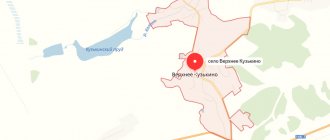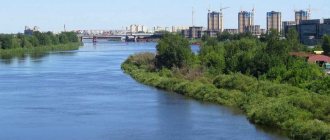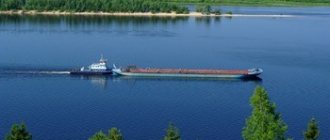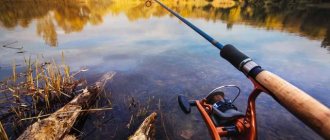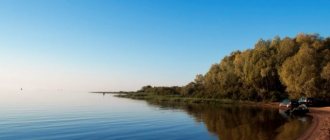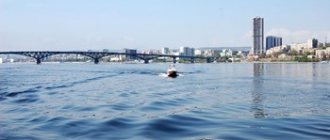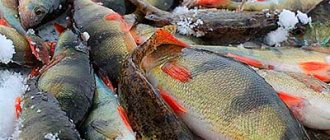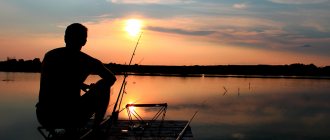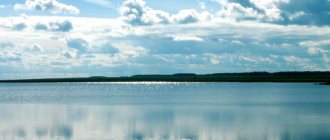Reservoirs for fishing
Reservoirs of Udmurtia
The main rivers of Udmurtia are the Vyatka and Kama; these rivers are the main water arteries of the region, intertwined with other smaller rivers. All these rivers are excellent for fishing.
Rivers flow through the Mozhginskaya Upland, such as: Umyak, Kilmez, Izha and Toyma. Rivers flow through the Verkhnekamsk Upland, including: Cheptsa, Kama and Vyatka. There is a watershed line that separates Kilmez from Cheptsy, and also in the north of Udmurtia there is another watershed that separates Cheptsy from the Kama and Vyatka.
Among other things, you need to pay attention to such places suitable for fishing as Lyp, Pykhta and Pyzep, which are the left tributaries of the Chepts, as well as its right tributaries such as Kei, Ubyt, Lekma, Sada, Sepych and Loza.
The main feature of the rivers of Udmurtia is their high asymmetry, so when fishing in these places you need to have a map of Udmurtia with you, and study it thoroughly the day before. Fishing on the Kama should be very good, and the view of the river itself is very picturesque, especially in autumn, so you get pleasure even just from the grandiose view. It is also advisable to use the services of guides from among local residents.
On the territory of Udmurtia there are a great many lakes and ponds, their total number is more than two thousand, if not more, and it is unlikely that anyone could count their true number, and many do not even have their names. These lakes, as a rule, are located in the floodplains of the Kama, Izh and Cheptsa rivers. The lakes within these rivers are simply teeming with vegetation and fish.
Of this number of lakes, only a few are suitable for quality fishing, but some are still present. Fishermen in Udmurtia especially highlight Lake Shanka, which is one of the Galanovsky lakes. Of the ponds, two can be distinguished - these are Izhevsky and Votkinsk ponds. The Izhevsk pond was dug in 1760 and is 12 kilometers long and two and a half kilometers wide.
The Votkinsk pond was dug a year earlier than the Izhevsk pond. The second most popular are the Kambarsky and Pudemsky ponds near the city of Kambarka.
Fishermen come to the reservoirs of Udmurtia to catch mainly bream and pike. But don’t think that there is no one else to fish for here. In Udmurtia, fish such as pike perch, ide, catfish, roach, crucian carp, carp, perch and many others are found in abundance. In some parts of Udmurtia you can also find burbot, silver carp, rudd, white-eye and sterlet, and this is not a complete list. And all these living creatures are evenly distributed along all the rivers of the region and are found there in large numbers.
Fishing on the Kama River
Fishing in Izhevsk
Starting as a small stream near the village of Karpushata in the north-eastern part of the republic, the Kama absorbs many tributaries and turns into a full-flowing river, the width of which in some places reaches 1.5 km.
The fish that live in the Kama are numerous and varied: along with the species traditional for central Russia, such as bream, chub, carp, silver bream, roach, perch, burbot, catfish, pike and pike perch, salmon, grayling, sterlet and even beluga And avid fishermen talk about the lucky ones who managed to catch taimen.
In total, there are more than 30 species of fish living in the Kama basin. And in the reservoirs there are also quite unusual ones, for example, Cherkhala sprat or round goby. All this abundance of fish guarantees that fishing in Udmurtia will be interesting and enjoyable. Of course, winter fishing is also exciting, but in summer nature is brighter and kinder, and there are more opportunities to diversify fishing.
On the Kama and its tributaries, such gear as a donka or zakidushka and a feeder with a feeder are popular among fishermen. Using them in quiet, shady backwaters you can catch bream and carp weighing 4–5 kilograms, and large crucian carp on the lake is also good catch.
True, fishing with a float rod in deep water without a boat is almost useless. The Kama is a deep river with elevation changes, so the main fish stay in the riffles or at depth.
But at the end of summer, when the water becomes colder and fog spreads over the rivers and lakes, the fish begin to gain fat.
Therefore, fishing in August in Udmurtia can be very successful, especially for spinning anglers who love to hunt predatory fish. The pike is not very active at this time, but the pike perch bites well on the jig, and, according to the fishermen, it is quite large, often weighing more than 2 kg. Both burbot and small catfish are caught using spinning rods, and large perch can also please the angler. Fishing in the Republic of Udmurtia
Moreover, perch, like chub, is a good fighter and resists to the last, so fishing for large fish can be an exciting and challenging activity. It is better to catch perch and chub not with a jig, but with a spinner, especially in sunny weather, when a bright spoon plays, reflecting the glare.
But in August, local fishermen catch bleak on a flywire, which surprises visitors who are in the mood for big “game.” But the locals know: bleak, although small, is a very tasty fish, especially fried until crispy.
Species diversity
Various marine animals are found in the reservoirs of Udmurtia, with fish being the most in demand. According to scientific evidence based on many studies, about 39 species of fish live in the region today. They inhabit:
- Lakes.
- Rivers.
- Ponds.
- Reservoirs.
Some private fish farms breed rare or cultivated species, such as carp, which is a domesticated variety of carp.
As for the number of representatives of the sturgeon family, over the past decades it has decreased significantly . This is explained by pollution of water bodies with wastewater. In addition, poaching and illegal fishing of rare fish are rampant in the area. For this reason, sturgeon are no longer considered an object of commercial and recreational fishing, being under the protection of the fisheries inspectorate.
One of the most common fish in Udmurt rivers and lakes is pike. Due to its large population, it is considered an indispensable part of commercial and recreational fishing. The toothy predator living in this area has an impressive size and is capable of demonstrating high growth rates and early maturation. Over four years of life, an individual gains about one kilogram of weight, and most often fishermen come across 2-5-year-old individuals. It is less common to obtain trophy prey at the age of 12–15 years. The weight of the latter can reach 20 kilograms.
Puberty of males ends at 3-4 years of age, when they begin to participate in spawning. As for females, their maturation ends at the age of four to five years. During the first spawning, females are able to lay about 5-10 thousand eggs. Large representatives of the species lay more than 250 thousand pieces. Depending on weather conditions, the spawning period can begin in late April or early May, provided that the water temperature reaches 4 degrees Celsius near the coastal waters.
The main part of the pike's diet is occupied by perch and roach, less often by small pike and ruff. Local authorities make a lot of efforts to prevent illegal fishing in the spring, when the fish go to spawn. Measures are being intensified to combat poaching of spawning pike.
Features of fishing in Udmurtia
Thanks to the well-developed river system, fishing in the region is very popular. Most rivers are small, no more than 10 km long. A large influx of fishermen is observed on the main river of the republic - the Kama.
Grayling and taimen are sometimes found in the upper reaches of the river and its tributaries.
Fishing on rivers and lakes can surprise even experienced fishermen. Indeed, in addition to the traditional commercial fish - pike, grayling, various salmon and sturgeon - here you can find the Black Sea red-cheeked pipefish, Cherkhala sprat, and round goby, which are completely untraditional for this region. According to experts, the new settlers climbed this far on the bottoms of river boats. You are guaranteed a rich catch and an unforgettable outdoor recreation if you contact fishing and tourism companies that organize special tours and provide guest houses and recreation centers. When going on vacation on your own, familiarize yourself with the fishing rules in a specific region and on a specific body of water. Fishing in the Udmurt Republic
The abundance and variety of fish make it possible for those who enjoy leisure time with a fishing rod to find a way to apply their skills at any time of the year. In the vastness of a large river, you can experiment with all types of winter fishing, completely realistically counting on big catches and trophies of various types of fish. It is quite difficult to list all the places popular with winter fishermen, but it is worth clarifying that the tributaries of the Kama, as well as numerous lakes and ponds, are no less interesting. It is often noted that on the Kama, the spills near the village of Zuevy Klyuchi are very interesting. It is worth keeping in mind that fishing on large rivers in winter has its own characteristics. It is important to know local hydrological and climatic conditions. This is important both from the point of view of fishing itself and safety. In order to avoid problems, we recommend using the services of experienced fishing guides and winter holiday organizers in the region. Successful fishing often involves traveling long distances, not only to bodies of water, but also to a specific fishing spot. Holiday organizers will help with organizing a comfortable holiday and will provide assistance in delivery to fishing spots and rental of equipment.
Paid fishing
In Udmurtia, as in many other regions of Russia, a network of “paid reservoirs” is developing. Carrying out is possible only in “closed reservoirs”. Licensed fishing of certain species of fish in rivers and lakes of “public use” has slightly different approaches and is regulated by other articles of environmental legislation. There are several fish farms in the republic, where, along with carp and grass carp, silver carp, you can catch various fish characteristic of the region: pike, perch, crucian carp, tench and others. Interesting “pay zones” include the Zavyalovsky ponds complex, Petrichinka pond and others. An important feature of private reservoirs for fishing is not only the presence of favorable conditions for outdoor recreation, but also the systematic stocking of the reservoir with fish, which guarantees a decent catch. At the moment, there are several private reservoirs in the region that provide...
Rudd and asp
As for the rudd, like the roach, this fish is found everywhere in the reservoirs of Udmurtia. Most often it is caught in lakes, oxbow rivers and clean backwaters with an abundance of vegetation. The length can reach 35 centimeters, and the weight is 1.5-2.0 kg. Puberty ends at the age of 3-4 years. As for spawning, it occurs in fish at the moment when the water warms up to a temperature of 18 degrees Celsius. As a rule, this happens in the last days of May. Moreover, in cold conditions, rudd spawns even in the middle or end of June.
If we talk about representatives of the river ichthyofauna, then you can find large asp there. By the way, it is occasionally caught in large lakes. According to local fishermen, the average size of commercial fish does not exceed 35-40 centimeters. Moreover, the fish weighs no more than 700-750 grams.
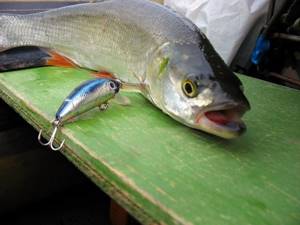
Maturation ends at 3-5 years of age, and the spawning season falls in the first ten days of the last spring month. Fertility indicators can reach 40-100 thousand eggs per clutch.
Most often, females spawn in places with a pronounced rocky bottom and fast current. Occasionally they prefer a sandy, flat bottom.
Juveniles eat cladocerans and copepods. Upon reaching one year of age, the asp turns from a peaceful inhabitant of the depths into a predator that attacks the fry. Adults prefer only fish.
It should be noted that the asp, like other representatives of the carp family, has pharyngeal teeth. Therefore, before eating food, it first crushes it, and does not swallow it, as pike does. When opening the belly after catching, it is problematic to determine what kind of fish ended up in the asp’s stomach.
see also
|
|
|
